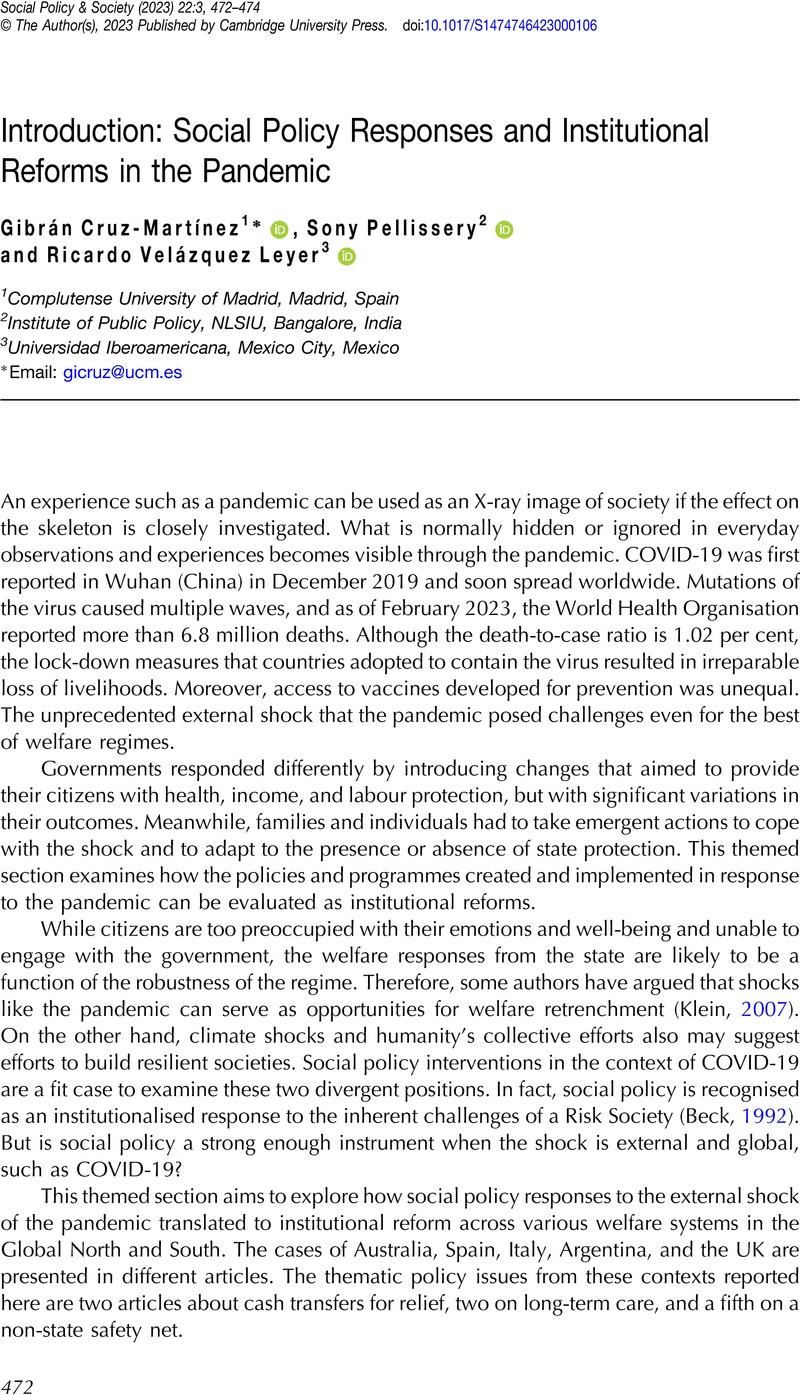No CrossRef data available.
Article contents
Introduction: Social Policy Responses and Institutional Reforms in the Pandemic
Published online by Cambridge University Press: 07 September 2023
Abstract
An abstract is not available for this content so a preview has been provided. Please use the Get access link above for information on how to access this content.

- Type
- Themed Section on Social Policy Responses and Institutional Reforms in the Pandemic
- Information
- Social Policy and Society , Volume 22 , Issue 3: THEMED SECTION: Social Policy Responses and Institutional Reforms in the Pandemic , July 2023 , pp. 472 - 474
- Copyright
- © The Author(s), 2023 Published by Cambridge University Press
References
Beck, D. J. and Gwilym, H. (2022) ‘The food bank: a safety-net in place of welfare security in times of austerity and the Covid-19 crisis’, Social Policy and Society, DOI: 10.1017/S1474746421000907.10.1017/S1474746421000907CrossRefGoogle Scholar
Cena, R. and Dettano, A. (2022) ‘About waiting: a reading from social policies and emotions in the context of a pandemic’, Social Policy and Society, DOI: 10.1017/S1474746422000331.10.1017/S1474746422000331CrossRefGoogle Scholar
Cruz-Martínez, G., Velazquez Leyer, R. and Pellissery, S. (2023) ‘Have social policy responses to COVID-19 been institutionalised?’, Social Policy and Society, this themed section.Google Scholar
Klein, N. (2007) The Shock Doctrine: The Rise of Disaster Capitalism, New York: Metropolitan Books.Google Scholar
León, M., Arlotti, M., Palomera, D. and Ranci, C. (2021) ‘Trapped in a blind spot: the Covid-19 crisis in nursing homes in Italy and Spain’, Social Policy and Society, DOI: 10.1017/S147474642100066X.10.1017/S147474642100066XCrossRefGoogle Scholar
Pearson, C., Watson, N., Brunner, R., Cullingworth, J., Hameed, S., Scherer, N. and Shakespeare, T. (2022) ‘Covid-19 and the crisis in social care: exploring the experiences of disabled people in the pandemic’, Social Policy and Society, DOI: 10.1017/S1474746422000112.10.1017/S1474746422000112CrossRefGoogle Scholar
Ramia, G. and Perrone, L. (2021) ‘Crisis management, policy reform, and institutions: the social policy response to COVID-19 in Australia’, Social Policy and Society, DOI: 10.1017/S1474746421000427.10.1017/S1474746421000427CrossRefGoogle Scholar
Seelkopf, L. and Starke, P. (2019) ‘Social policy by other means: theorising unconventional forms of welfare production’, Journal of Comparative Policy Analysis: Research and Practice, 2, 3, 219–34.Google Scholar


